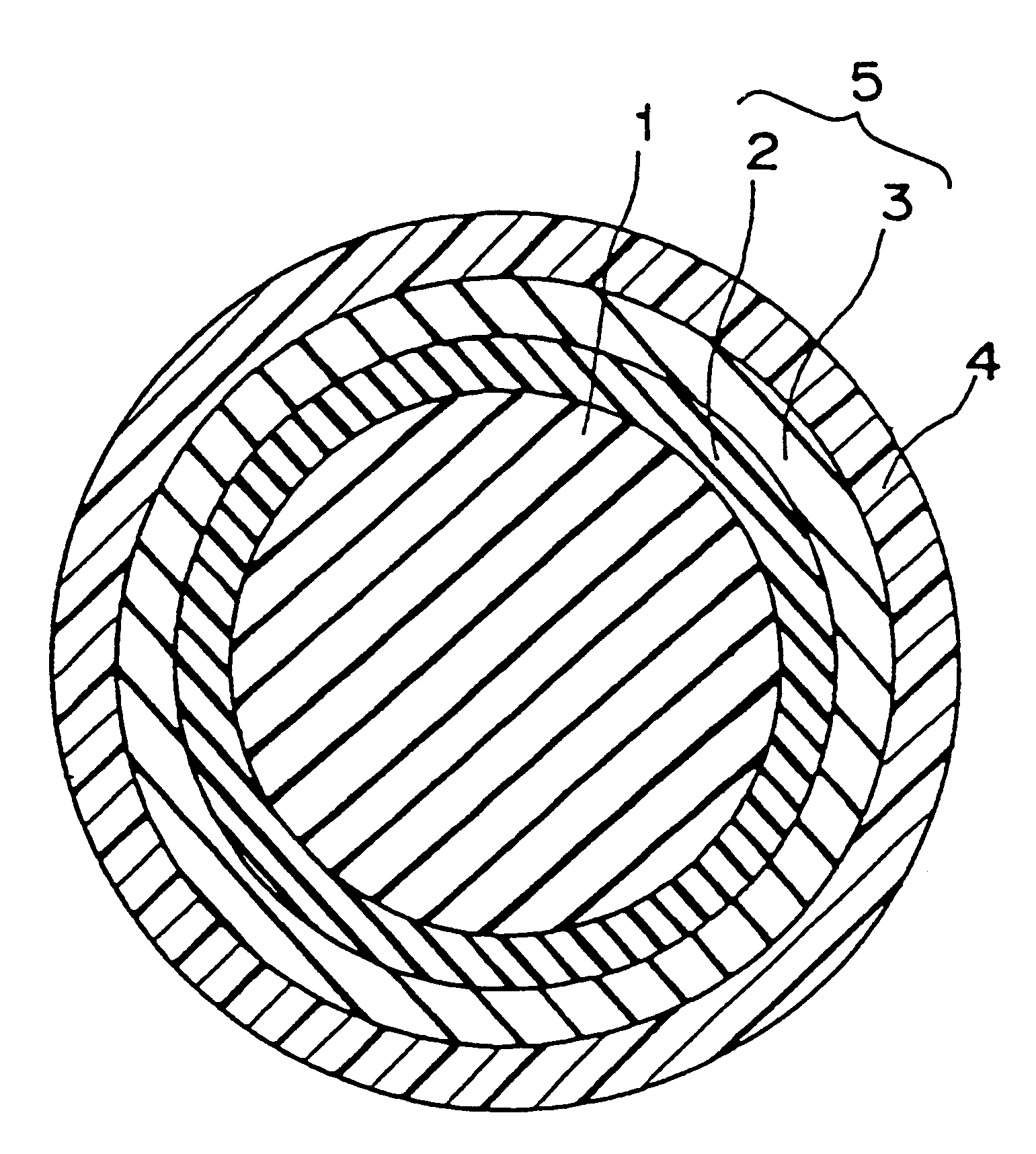Four piece solid golf ball
a golf ball and solid technology, applied in the field of solid golf balls, can solve the problems of poor controllability, poor shot feel, and high hardness of two-piece solid golf balls, and achieve the effects of reducing flight distance, reducing rebound performance, and improving other defects
- Summary
- Abstract
- Description
- Claims
- Application Information
AI Technical Summary
Benefits of technology
Problems solved by technology
Method used
Image
Examples
examples 1 to 6
Preparation of a Center
A composition for center was prepared by mixing the ingredients shown in Table 1 and then press-molded at 140.degree. C. for 25 minutes, followed by press-molding at 165.degree. C. for 20 minutes to form a center. The diameter and JIS-C hardness are shown in Table 2.
Formation of an Inner Layer of an Intermediate Layer
The center obtained above was covered by injection molding with the resin composition for inner layer, of which ingredients were shown in Table 1. The thickness and JIS-C hardness of the inner layer are shown in Table 2.
Formation of an Outer Layer of an Intermediate Layer
On the inner layer-covered center, a rubber composition for outer layer was covered and then press-molded at 155.degree. C. for 20 minutes. The ingredients of the rubber composition are shown in Table 1. The thickness and JIS-C hardness of the outer layer are shown in Table 2.
Formation of a Cover
On the outer layer-covered center, a resin composition for cover was covered by inject...
examples 7 to 12
Preparation of a Center
A composition for center was prepared by mixing the ingredients shown in Table 3 using a mixing roller and then press-molded at 140.degree. C. for 25 minutes, followed by press-molding at 165.degree. C. for 8 minutes to form a center. The diameter and JIS-C hardness are shown in Table 4.
Formation of an Inner Layer of an Intermediate Layer
On the center, a rubber composition for inner layer was covered and then press-molded at 155.degree. C. for 20 minutes. The ingredients of the rubber composition are shown in Table 3. The thickness and JIS-C hardness of the inner layer are shown in Table 4.
Formation of an Outer Layer of an Intermediate Layer
The inner layer-covered center obtained above was covered by injection molding with the resin composition for outer layer, of which ingredients were shown in Table 3. The thickness and JIS-C hardness of the inner layer are shown in Table 4.
Formation of a Cover
On the outer layer-covered center, a resin composition for cover ...
examples 13 to 17
Preparation of a Center
A composition for center was prepared by mixing the ingredients shown in Table 5 and then press-molded at 140.degree. C. for 25 minutes, followed by press-molding at 165.degree. C. for 8 minutes to form a center. The diameter and JIS-C hardness are shown in Table 6.
Formation of an Inner Layer of an Intermediate Layer
The center obtained above was covered by injection molding with the resin composition for inner layer, of which ingredients were shown in Table 5. The thickness and JIS-C hardness of the inner layer are shown in Table 6.
Formation of an Outer Layer of an Intermediate Layer
The inner layer-covered center obtained above was covered by injection molding with the resin composition for outer layer, of which ingredients were shown in Table 5. The thickness and JIS-C hardness of the inner layer are shown in Table 6.
Formation of a Cover
On the outer layer-covered center, a resin composition for cover was covered by injection molding and then painted thereon t...
PUM
 Login to View More
Login to View More Abstract
Description
Claims
Application Information
 Login to View More
Login to View More - R&D
- Intellectual Property
- Life Sciences
- Materials
- Tech Scout
- Unparalleled Data Quality
- Higher Quality Content
- 60% Fewer Hallucinations
Browse by: Latest US Patents, China's latest patents, Technical Efficacy Thesaurus, Application Domain, Technology Topic, Popular Technical Reports.
© 2025 PatSnap. All rights reserved.Legal|Privacy policy|Modern Slavery Act Transparency Statement|Sitemap|About US| Contact US: help@patsnap.com


